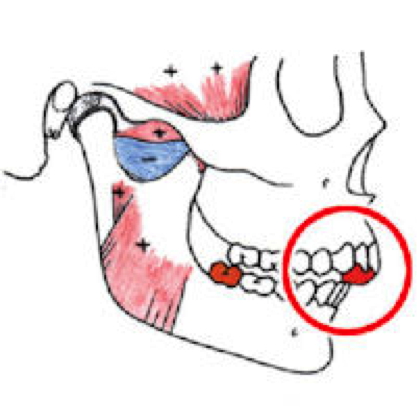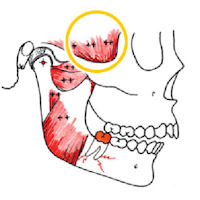
Do You Need an Occlusal Splint or Night Guard?
There is a good chance that someone you know is wearing a plastic appliance called an occlusal splint. Occlusal splints come in many different designs and are prescribed by your dentist for different but very specific reasons.
 The most common type of occlusal splint is called a permissive splint. This is an appliance that may be fitted to either the upper or the lower teeth. The biting surface of a permissive splint is smooth and fairly flat. The teeth that contact against it when the jaw closes can slide freely against the flat surface so the muscles that move the jaw are able to direct jaw closure free of any deflective tooth inclines that can interfere with peaceful muscle activity.
The most common type of occlusal splint is called a permissive splint. This is an appliance that may be fitted to either the upper or the lower teeth. The biting surface of a permissive splint is smooth and fairly flat. The teeth that contact against it when the jaw closes can slide freely against the flat surface so the muscles that move the jaw are able to direct jaw closure free of any deflective tooth inclines that can interfere with peaceful muscle activity.
On patients with a poor bite relationship, the jaw joints (TMJs) may have to be displaced from their sockets to make the teeth fit together when the jaw closes. Jaw muscles that have to hold the joints out of position every time the teeth come together, get tired and may become painful. A permissive splint is just a way of correcting the bad bite in a reversible manner, by covering up the deflective inclines on the teeth with a plastic material. The purpose is to create a new temporary bite surface that is in harmony with the jaw joints.
 Sometimes the jaw muscles become so fatigued from trying to avoid a sore tooth, the muscles may go into spasm. An occlusal splint that separates the back teeth, but allows only the front teeth to contact a smooth flat surface, provides quick relief as the muscles are free to seat the jaw joints in their sockets without interference from the bite disharmony. If there are no structured disorders in the joints, the sore muscles become comfortable, usually within hours or, at most, two to three days, at which time the comfortable jaw to jaw relationship can be ascertained and the bite can be corrected.
Sometimes the jaw muscles become so fatigued from trying to avoid a sore tooth, the muscles may go into spasm. An occlusal splint that separates the back teeth, but allows only the front teeth to contact a smooth flat surface, provides quick relief as the muscles are free to seat the jaw joints in their sockets without interference from the bite disharmony. If there are no structured disorders in the joints, the sore muscles become comfortable, usually within hours or, at most, two to three days, at which time the comfortable jaw to jaw relationship can be ascertained and the bite can be corrected.
When a high crown or filling interferes with closure, the interfering tooth can become sore. This activates protective muscle responses that, when prolonged, can spread to other muscles causing pain. Headaches are common along with sensitivity to cold in the tooth.
An occlusal splint that fits over the front teeth prevents the sore tooth from all contact and allows the TMJs to seat completely. If there are no structural problems in the jaw joints, pain is eliminated in the tooth as well as the muscles. The principle works the same for any bite interference.
 Once the correct jaw relationship is established, the appliance can be modified to provide simultaneous contact for all the teeth in harmony with the joints and the muscles. Use of a removable appliance to correct the bite is referred to as reversible occlusal treatment. However, if there are no problems within the TMJs, it is permissible to proceed with correcting the bite directly on the teeth. There is really nothing wrong with such irreversibleocclusal changes if the correct position of the jaw joints can be assured with accuracy. The advantage is that it is then unnecessary to wear an add on appliance.
Once the correct jaw relationship is established, the appliance can be modified to provide simultaneous contact for all the teeth in harmony with the joints and the muscles. Use of a removable appliance to correct the bite is referred to as reversible occlusal treatment. However, if there are no problems within the TMJs, it is permissible to proceed with correcting the bite directly on the teeth. There is really nothing wrong with such irreversibleocclusal changes if the correct position of the jaw joints can be assured with accuracy. The advantage is that it is then unnecessary to wear an add on appliance.
There is a common misconception that occlusal splints work by increasing the vertical height of the teeth. Building up the natural teeth to the level of the occlusal appliance is rarely necessary and is in many cases clearly contraindicated if the bite can be corrected by reshaping the teeth directly or by more conservative treatment than a major full mouth reconstruction. The jaw joints, the muscles and the teeth can almost always be completely comfortable without raising the bite level.
Occlusal splints do their job by preventing deflective tooth disharmonies from forcing the TMJs to displace. Once the joints can completely seat in their sockets without interference from the teeth, intact, healthy TMJs can rotate and function in complete comfort within a range of different bite levels.
A different type of occlusal splint is called directive splint. Directive splints are only used for specific types of structural disorders within the jaw joint articulation. They direct the jaw joints to a pre-determined position in their respective sockets to enhance the healing process. They must be used with caution and only after a meticulous examination to determine the exact nature of the joint’s structural problem.
In patients who would best be served by extensive correction of serious bite disorders, an occlusal splint may provide a reasonable alternative if limited time or resources require a compromised treatment approach.
An occlusal splint is often prescribed for nighttime use to reduce the wear and tear on teeth when a serious bruxing or clenching problem is active.
In some patients with certain types of structural TMJ disorders, it may be necessary to wear an occlusal splint for an extended period of time. Occlusal appliances made for long term use should be comfortable and in most cases should provide a smooth, even surface for all the teeth that contact against it.
What You Should Know About Occlusal Splints
- If the appliance does not make your bite more comfortable, it is probably not in correct harmony with your TMJs
- Occlusal splints usually have to be adjusted after placement. As the jaw joints are freed up to go to a more physiologic position in their sockets, the biting surface of the appliance may need to be corrected to maintain harmony with the TMJs. The number of times adjustments are needed is dependent on the structural condition of the TMJs.
- Occlusal splints are not a panacea. Their effectiveness is dependent on a very carefully made diagnosis and appliance design that is directed at solving a specific type of disorder.
- Patients should feel free to ask their dentist to explain the diagnosis and how the appliance can help.

